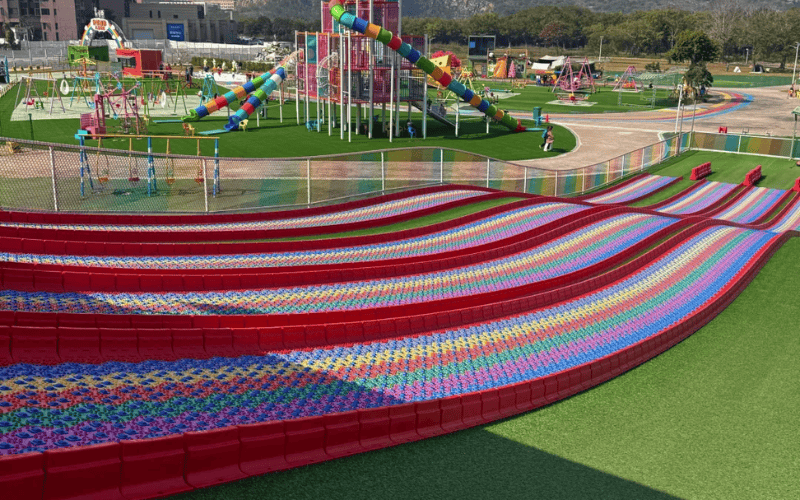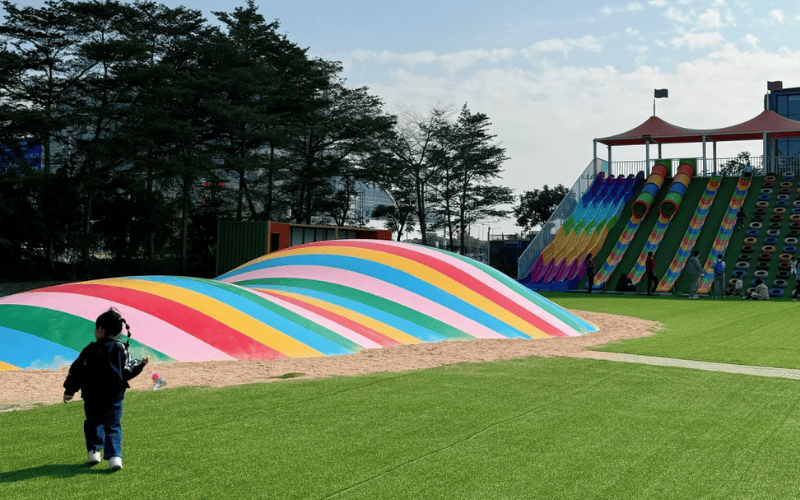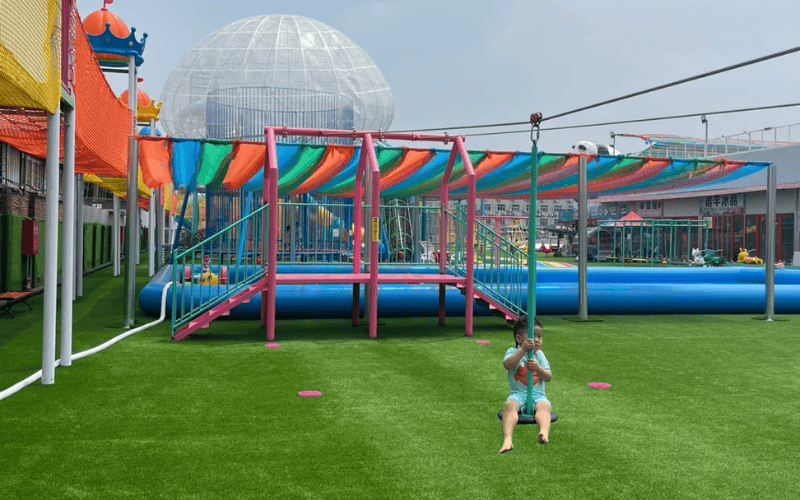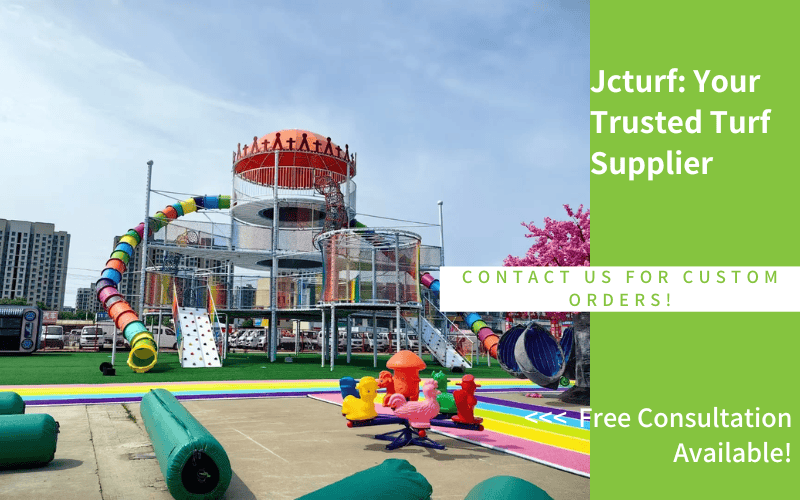If you’re building a playground, turf padding isn’t optional — it’s essential. This guide covers everything you need to know about playground turf padding: what it is, why it matters, and which materials work best. We’ll walk you through how to choose the right padding, install it on concrete or soil, and understand safety-based thickness requirements. You’ll also see how turf padding compares to no padding, what maintenance is needed, and how much it costs. Finally, we wrap up with expert answers to common questions so you can plan with confidence.
What Is Playground Turf Padding?
When children run, jump, and fall on a playground, the surface beneath their feet plays a big role in keeping them safe. That’s where playground turf padding comes in.
Playground turf padding is a layer of shock-absorbing material installed underneath artificial grass. It’s designed to reduce the force of impact when someone falls. This padding helps meet critical safety standards by lowering the risk of head injuries and other serious accidents.
You’ll often hear terms like “impact attenuation” or “shock pad” — these refer to how well the padding cushions a fall. While the artificial turf adds softness and traction, it’s the padding underneath that delivers true protection.
In most modern playgrounds, turf padding isn’t just a nice-to-have — it’s essential. It transforms a basic turf surface into a safer play environment that gives both parents and facility owners peace of mind.
Why Is Padding Necessary Under Artificial Grass for Playgrounds?
At first glance, artificial grass may seem soft enough for kids to play on. But when it comes to real falls — from slides, swings, or climbing frames — turf alone doesn’t offer enough protection.

Playground turf padding helps absorb the shock when a child hits the ground. It significantly reduces the risk of head injuries and broken bones by softening the impact. That’s why padding is a key part of most fall safety systems.
In many countries, safety standards require playground surfaces to meet critical fall height criteria. Without proper padding, your playground might fail to meet those rules — putting children at risk and exposing you to liability.
There’s also comfort to think about. Padding creates a more cushioned surface that feels better underfoot. Children can run, kneel, or crawl more comfortably, especially in long play sessions.
To recap, turf padding is necessary because it:
- Improves safety by reducing injury risk
- Helps meet fall height compliance standards
- Enhances comfort for everyday play
In short, it’s not just an add-on — it’s a safety essential you shouldn’t skip.
Best Types of Playground Turf Padding Materials
Choosing the right playground turf padding material is key to building a safe and long-lasting play surface. From soft underlayment in residential yards to impact-rated solutions for schools and parks, there are several types of padding to consider.
In this section, we’ll explore the most common options: shock pads for safety and durability, foam padding for comfort in light-use areas, rubber underlay for heavy-duty needs, and a few specialty systems designed for custom installations.
Shock Pads
Shock pads are one of the most widely used options for playgrounds. They’re typically made from recycled foam or rubber and come in pre-formed panels or rolls. What makes them popular is their high impact absorption and long-term performance. They’re also lightweight and relatively easy to install. Shock pads are ideal when you need to meet strict fall height requirements, especially for public playgrounds or schools.
Foam Padding
Closed-cell foam padding provides excellent cushioning and is often used in residential or light-use playgrounds. It’s soft, water-resistant, and comfortable underfoot. However, foam pads may compress over time and are usually less durable than shock pads in high-traffic areas. This option works well for backyards or daycare centers where playtime is frequent but less intense.
Rubber Underlay
Rubber underlay is a dense, flexible layer made from recycled rubber granules. It’s known for its durability and slip resistance. It handles moisture well and holds up in tough outdoor conditions. However, rubber underlay is heavier and may require more effort to install. It’s often chosen for areas with heavy equipment or higher structural demands.
Other Specialty Systems
Some systems combine multiple layers — like foam plus mesh or rubber plus drainage tile — to meet specific project needs. These hybrid options offer custom fall ratings and better drainage but come at a higher cost. If you’re dealing with unique playground surfaces or drainage concerns, these might be worth considering.
How to Choose the Right Turf Padding for Your Playground?
Picking the right turf padding for your playground depends on more than just the material itself. Each project has its own safety needs, ground conditions, and usage levels. In this section, we’ll walk you through the four key factors to help you make the best choice: safety compliance, surface type, drainage, and budget.

Safety and Fall Height Requirements
If your playground includes equipment like swings, climbers, or slides, you’ll need padding that meets critical fall height standards. Check local regulations such as ASTM F1292 or EN1177. Shock pads are often the go-to here, offering reliable impact protection. If you’re unsure about the required fall height, a certified installer or product spec sheet can guide you.
Type of Surface or Sub-Base
What kind of ground are you working with — concrete, compacted soil, or gravel? Some paddings, like foam, work best on softer soil, while rubber underlay and shock pads are suitable for hard surfaces. Your base layer affects both installation and long-term performance.
Drainage and Weather Resistance
In outdoor playgrounds, especially in wet or humid areas, proper drainage is crucial. Padding with built-in drainage channels or permeable materials can prevent water buildup and extend turf life. Poor drainage can lead to soggy turf, mold issues, or freeze-thaw damage in colder climates.
Budget and Lifespan Balance
Padding comes at different price points. Foam is often cheaper upfront, but may wear out faster. Shock pads and rubber underlays cost more, but last longer and perform better under heavy use. Look at the total cost of ownership — not just the initial expense.
Can You Install Turf Padding on Concrete or Hard Surfaces?
Yes — you can install playground turf padding on concrete or other hard surfaces, and it’s more common than you might think. In fact, many urban playgrounds, rooftop play areas, and schoolyards start with a solid base like concrete or asphalt.
Turf padding systems are specifically designed to be adaptable. Shock pads and rubber underlays, for example, perform well on rigid sub-bases. They can be laid directly over the surface, usually with adhesives or interlocking mechanisms, depending on the product design.
You won’t need to remove the existing hard surface. But installation must be handled carefully to ensure safety and longevity.
Here’s what you need to keep in mind:
- Surface preparation is critical — the concrete must be clean, level, and free of loose particles.
- Choose a padding product rated for hard surfaces, ideally with tested fall height performance.
- Check drainage solutions — padding may need built-in drainage or perimeter channels to avoid water buildup.
- Use the right adhesive system if glue-down installation is required; not all adhesives bond well with certain concrete finishes.
With proper planning and the right materials, installing turf padding on concrete is not only possible — it’s a smart way to convert underused hard areas into safe, functional play spaces.
How Is Playground Turf Padding Installed?
Installing playground turf padding is a structured process that ensures both safety and performance. While the exact method depends on the type of padding and site conditions, most installations follow a clear step-by-step flow.
Here’s a simplified overview of how the process typically works:
- Prepare the Base Surface
Clear debris, level the surface, and compact the base if necessary. For concrete, make sure it’s clean and dry. A smooth, stable sub-base is essential for padding to sit evenly. - Lay the Padding System
Roll out or place the padding panels according to the layout plan. Make sure the padding fits tightly, with minimal gaps. For some products, interlocking edges or adhesive strips help keep pieces in place. - Secure the Padding (if required)
On hard surfaces, adhesives or mechanical fasteners may be used to fix the padding to the base. For soft sub-bases like crushed stone, weight and edging may be sufficient. - Add a Drainage Layer (optional)
If your padding doesn’t have built-in drainage, a thin drainage mat or geotextile may be added to prevent water pooling. - Install the Artificial Turf
Lay turf rolls over the padding, join seams with turf tape or adhesive, and secure the edges. Make sure the turf stretches evenly across the surface without wrinkles or bubbles.
A few tips: Always follow the padding manufacturer’s guidelines, especially regarding adhesives and drainage. And if the playground will handle heavy foot traffic or tall equipment, double-check that your padding meets fall height safety ratings.
How Thick Should Playground Turf Padding Be?
There’s no single “correct” thickness for playground turf padding — it all depends on how the playground will be used and how high children might fall. The key factor is critical fall height, or CFH, which measures how well a surface can absorb impact from a given height.
Padding thickness directly affects CFH performance. Thicker padding usually offers better shock absorption, but also costs more and may require special installation. That’s why standards like ASTM F1292 or EN1177 specify test-based fall height ratings rather than fixed thickness rules.
| Playground Type | Typical Padding Thickness | CFH Coverage Estimate |
| Backyard play area | 10–15 mm foam | Up to 1.0 meter fall |
| Preschool / daycare | 20–25 mm foam or pad | Up to 1.5 meters |
| Public park playground | 30–50 mm shock pad | 2.0 meters or more |
| High-climb structures | 50+ mm, often multi-layer | Custom-tested, 2.5m+ |
For general guidance, here’s what different settings often require:Keep in mind: two products with the same thickness may not perform the same. Always look for third-party CFH certifications instead of relying on thickness alone. Thickness is just part of the system — material type, density, and installation method all affect safety.
Playground Turf Padding vs. No Padding: Real Risks Compared
It might be tempting to skip playground turf padding — especially if the turf itself feels soft. But the difference between turf with and without padding becomes clear the moment someone falls.
With padding, impact energy is absorbed before it reaches the body. It reduces injury risks, helps meet fall safety standards, and gives both kids and parents peace of mind. Many schools and public parks require padding for compliance and liability protection.

Without padding, the turf sits directly on a hard base — usually compacted soil or concrete. That means minimal shock absorption and greater force on impact. Even a fall from just one meter can result in serious injury if the surface doesn’t cushion properly.
Here are just a few risks of skipping turf padding:
- Increased chance of head or bone injuries during falls
- Non-compliance with critical fall height regulations (ASTM, EN)
- Greater wear and tear on the turf due to lack of underlayer support
- Higher long-term liability and maintenance costs
Ultimately, the choice isn’t about comfort — it’s about safety. Padding turns a turf surface into a fall-safe system. If children are expected to run, climb, or jump, padding isn’t optional. It’s your frontline defense against injury.
Maintenance Tips for Turf Padding Systems
While playground turf padding is designed to be low-maintenance, it still benefits from regular care — especially in high-traffic or outdoor environments. Proper upkeep can extend its performance, prevent hidden damage, and maintain a safe play surface.
Here are a few practical maintenance tips to keep your turf padding system in top shape:
- Inspect the surface regularly
Look for signs of turf shifting, unusual softness, or uneven spots that may indicate padding displacement or damage underneath. - Clean debris and organic buildup
Leaves, mud, and other debris can trap moisture and promote bacterial growth. Use a blower or brush regularly to keep the surface clean. - Check drainage function after rainfall
If water pools on the surface or takes too long to dry, inspect the padding’s drainage layer or edge channels. Persistent moisture can degrade materials over time. - Monitor seam integrity and edge fixing
Padding systems that rely on adhesives or interlocks can shift slightly over months. Ensure that seams and perimeter edges remain tight and secure. - Avoid heavy equipment or dragging furniture
Turf padding isn’t meant to bear concentrated loads from carts, benches, or vehicles. Use proper lifting or temporary protections when needed.
Consistent, light-touch maintenance helps prevent larger issues down the line. Well-maintained padding keeps your playground safer, drier, and longer-lasting — and that means fewer surprises for you.
Cost Guide: What to Expect When Budgeting for Playground Turf Padding
Understanding the cost of playground turf padding is essential when planning your project. While exact prices vary by region, supplier, and project size, having a rough idea of the budget helps avoid surprises.
On average, you can expect turf padding systems to range between $3 to $10 per square foot, including materials and basic installation. Smaller residential areas may fall on the lower end, while large public playgrounds with safety-rated shock pads will be higher.
Several key factors influence the total cost:
- Type of padding material
Foam is typically less expensive than rubber or certified shock pads, but may have a shorter lifespan. - Fall height rating requirements
Higher fall protection often means thicker or layered padding systems — and more cost. - Installation complexity
Uneven terrain, hard surfaces, or drainage needs can increase labor and preparation costs. - Project size and scale
Larger areas may benefit from bulk pricing, but also come with more turf seams, joins, and logistics.
Beyond base costs, consider additional expenses like:
- Ground preparation (especially for hard or uneven sub-bases)
- Adhesives or fastening systems
- Drainage layers or accessories
- Transportation and delivery of bulky padding materials
The best way to approach budgeting is to focus on value over initial price. Padding protects children, reduces injury risks, and extends turf life — which means lower long-term maintenance and fewer liability concerns. A slightly higher investment now often pays off over years of safer play.
Is playground turf padding waterproof?
Playground turf padding is usually water-resistant, not fully waterproof. Most systems are designed with drainage in mind, allowing water to pass through and away from the surface. Always check whether the padding includes built-in drainage channels or needs a separate drainage layer.
Does padding affect how the turf feels underfoot?
Yes — turf padding adds noticeable softness and bounce. It improves comfort and reduces impact, especially in high-traffic play zones. Without it, turf may feel flat or hard, especially over time.
How long does turf padding last?
Quality turf padding typically lasts 8–15 years, depending on material and usage. Foam may degrade faster in heavy-use areas, while shock pads and rubber systems hold up longer. Proper installation and maintenance directly affect the lifespan.
Can padding be added to an existing turf installation?
Yes, you can retrofit playground turf padding beneath an existing turf surface, but it requires partial removal and reinstallation. The process involves lifting the turf, laying the padding, and reattaching the turf. It’s more labor-intensive than new installs, but often worthwhile for safety upgrades.



